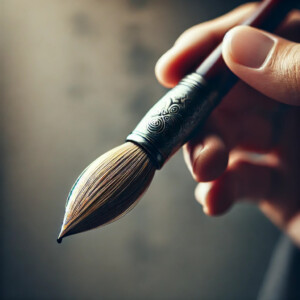Brief Overview of Japanese Calligraphy (Shodo) Japanese calligraphy, or Shodo, is an esteemed art form that marries visual beauty with linguistic expression. Rooted in ancient traditions, it’s both a discipline and a creative pursuit, revered for its simplicity and depth.
Importance in Japanese Culture Calligraphy holds a special place in Japanese culture, symbolizing the harmony of mind, body, and spirit. It’s more than writing; it’s a meditative practice that reflects the calligrapher’s inner state, embodying the essence of Zen philosophy.
History of Japanese Calligraphy
Origins and Evolution Japanese calligraphy traces its origins to Chinese calligraphy, introduced to Japan around the 6th century. Initially, it mirrored Chinese styles but gradually developed its own unique forms and techniques.
Key Historical Periods and Influences
- Introduction of Chinese Characters (Kanji): The foundation of Japanese calligraphy, Kanji was adopted from Chinese script, laying the groundwork for Japanese writing.
- Development of Kana: In the 9th century, the Japanese created two syllabaries, Hiragana and Katakana, to complement Kanji, enriching the script.
- Influence of Buddhism and Zen: Buddhism’s arrival in Japan profoundly influenced calligraphy, emphasizing the spiritual and meditative aspects of the art.
Techniques and Styles
Basic Tools: Brush, Ink, Paper, Inkstone The traditional tools of calligraphy—brush (fude), ink (sumi), paper (washi), and inkstone (suzuri)—are integral to the practice, each contributing to the aesthetic and technique.
Fundamental Techniques and Strokes Mastering basic strokes and techniques is essential for any calligrapher. These include:
- Kaisho (Block Script): Characterized by clear, straight strokes.
- Gyosho (Semi-Cursive): A more fluid style that balances legibility and speed.
- Sosho (Cursive): Highly stylized and free-flowing, reflecting the calligrapher’s personal flair.
- Kana Script: Developed specifically for the Japanese language, used for phonetic writing.
Notable Calligraphers
Historical Figures
- Ono no Michikaze: Often considered the father of Japanese calligraphy, his works set the standard for subsequent generations.
- Wang Xizhi: A Chinese calligrapher whose style profoundly influenced Japanese calligraphy.
Contemporary Calligraphers and Their Contributions Modern calligraphers continue to evolve the art form, blending traditional techniques with contemporary aesthetics. Figures like Shingai Tanaka and Yuichi Inoue have expanded the boundaries of calligraphy, incorporating it into modern art and design.
Modern Influences
Calligraphy in Modern Japanese Design and Art Contemporary Japanese design often features calligraphy, reflecting its timeless appeal. It’s seen in various media, from graphic design to architecture.
Integration in Fashion, Architecture, and Digital Media Calligraphy’s influence extends to fashion, where it adorns clothing and accessories, and architecture, where its forms inspire structural design. In digital media, calligraphy fonts and motifs are ubiquitous.
Calligraphy Workshops and Classes for Enthusiasts With a growing interest in traditional arts, calligraphy workshops and classes have become popular, offering enthusiasts a chance to learn and practice under expert guidance.
Tips for Beginners
Starting Materials and Resources Beginners should start with basic tools: a brush, ink, paper, and an inkstone. Numerous resources, including books and online tutorials, can guide initial practice.
Basic Exercises and Practice Routines Regular practice is key to mastering calligraphy. Beginners should focus on basic strokes and simple characters, gradually progressing to more complex forms.
Common Mistakes and How to Avoid Them Common mistakes include incorrect brush handling and inconsistent stroke pressure. These can be mitigated with mindful practice and attention to technique.
Conclusion
Recap of Calligraphy’s Enduring Significance Japanese calligraphy remains a vibrant and respected art form, bridging past and present. Its practice is a journey of self-discovery and artistic expression.
Encouragement to Explore and Practice Calligraphy Whether for personal enrichment or artistic pursuit, calligraphy offers a rewarding experience. Aspiring calligraphers are encouraged to explore and immerse themselves in this timeless art.
Visuals and Extras
High-Quality Images of Calligraphy Examples Incorporate images showcasing different styles and notable works of calligraphy to visually enhance the article.
Videos of Calligraphers at Work Embedding videos of calligraphers practicing their art can provide readers with a dynamic understanding of the techniques and beauty of calligraphy.
Links to Resources and Further Reading Provide links to additional resources, such as books, websites, and online courses, for readers interested in delving deeper into Japanese calligraphy.

Comment